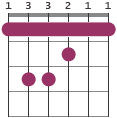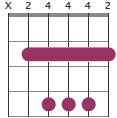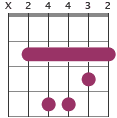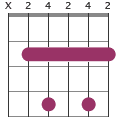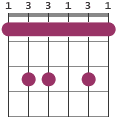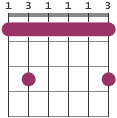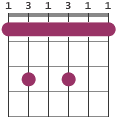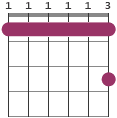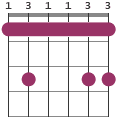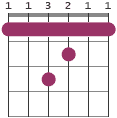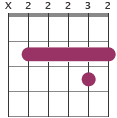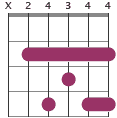Barre chords
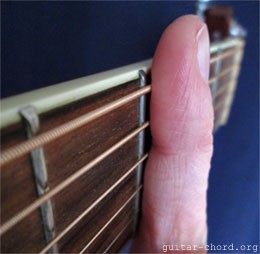 Barre chords on the guitar can be quite demanding in the beginning. To play a barre chord (can also be spelled bar chord or barré chord), you have to press down several strings with one finger, see picture to the right. This isn’t an easy thing to do before the involved muscles have been strengthened. But all there’s to it's patience as you by time will get stronger.
Barre chords on the guitar can be quite demanding in the beginning. To play a barre chord (can also be spelled bar chord or barré chord), you have to press down several strings with one finger, see picture to the right. This isn’t an easy thing to do before the involved muscles have been strengthened. But all there’s to it's patience as you by time will get stronger.
It's very much worth the effort to learn barre chords as it lays many possibilities in front of you with these chords. The advantages with barre chords are primarily that they are movable and have the same fingerings, which make them easy to memorize.
Common six-strings barre chords with E shapes
F (major)
Fm (minor)
F7 (dominant)
More barre chords
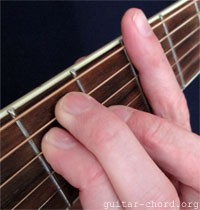 The reason why it's called ”E shape” depends on that the fingerings are the same as for chords that emerge from various E chords. That makes it a barre chord is that you lay your index finger over the six strings behind (i.e. nearer the headstock of the guitar) the rest of the chord shape, see picture to the right.
The reason why it's called ”E shape” depends on that the fingerings are the same as for chords that emerge from various E chords. That makes it a barre chord is that you lay your index finger over the six strings behind (i.e. nearer the headstock of the guitar) the rest of the chord shape, see picture to the right.
The diagrams above shows F major, F minor and F7th chords, but the great thing with barre chords is that they are movable and keeps the same shape all over the fretboard. So regardless if it's an F, G or A chord you can use the exact same chord shape, only changing the position on the guitar's fretboard. The table below tells you where to find each barre chord on the correct frets according to the notes of the guitar. See also Fretboard note decals.
| Shape |  |
|||||||
|---|---|---|---|---|---|---|---|---|
| Fret | 1 | 2 | 3 | 4 | 5 | 6 | 7 | 8 |
| Chord | F | F#/Gb | G | G#/Ab | A | A#/Bb | B | C |
Let’s take an example how to place your fingers for a specific chord. If you want to play a G barre chord you put the index finger on the third fret and then add the other fingers. This chord type is sometimes called root 6th bar chord (and is practical to abbreviate R6, such in R6 G, when doing quick notes of progressions).
Common five-strings barre chords with A shapes
B (major)
Bm (minor)
B7 (dominant)
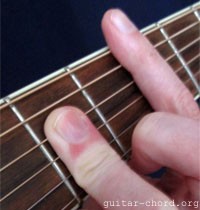 The reason why it's called ”A shape” is because the fingerings are the same as for chords that emerge from various A chords (it's the same story as we already know from the E shape, see above).
The reason why it's called ”A shape” is because the fingerings are the same as for chords that emerge from various A chords (it's the same story as we already know from the E shape, see above).
This time you put your index finger over the five strings behind (i.e. nearer the headstock of the guitar) the rest of the chord shape, see picture to the right. You should play on all strings except the lowest (if you press down five or six string with your index finger doesn't matter).
This chord type is sometimes called root 5th bar chord (and is practical to abbreviate R5, such in R5 C, when doing quick notes of progressions).
| Shape |  |
|||||||
|---|---|---|---|---|---|---|---|---|
| Fret | 1 | 2 | 3 | 4 | 5 | 6 | 7 | 8 |
| Chord | A#/Bb | B | C | C#/Db | D | D#/Eb | E | F |
Let’s take an example how to place your fingers for a specific chord. If you want to play a C barre chord you put the index finger on the third fret and then add the other fingers.
See complete diagram overview for major and minor barre chords....
Comments
Would it not be enough with one of these shapes? The answer is about the movement along the guitar neck: with only one shape it would sometimes be very long jumps between two barre chords.
But the subject doesn’t stop here ... Although the more economical movements are preferable for practical reasons, it may still not always be the most desirable choice. In some cases, you might want to keep the same shape trough a chord progression as you like the sound you get that way.
Fingerings
There are situations in which different fingerings can be preferred by different players. The major chord barre shape with the root on the fifth string are common to play with two different approaches:
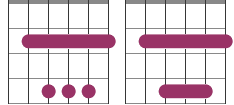
By using the second shape, the chance is that the first string gets muted, but that is not a problem in most cases since the same note is already represented at the fourth string.
More barre chords
Fm6
Fm9
F11
Fm11
F13
Fm13
Fadd11
B6
B11
Bm11
Bmaj13
These are barre shapes for various chord groups that can be used all over the fretboard. If you move the shape for Fm6 one step up the fretboard you get Gm6 and so on. Also notice that F11 is identical with F7sus4 in this specific case.
For pdf-format and additional guidance, see The Barre Chord Chart ebook with 200+ diagrams and 25 shapes.
Chord progressions
The same progressions you already know with open can often work well, but because of the different position, some new ways for progression can be found:
C (X35553) - C/D (X5555X)
You simply remove all the fingers except the index finger (a possible continuation is ... F - G).
Other barre chord progressions are:
C# - G# - F# - G#
C#m7 - F#m7 - Bm7 - A - E
F - A - Bb - G
Bm - A - G - F#7
F#7 - A7 - G#7 - C#7 - B7 (Day Tripper)
In the second, the A chord could be played in open position.
Definition of barre chords
What makes a chord to a barre chord is that you lay your index finger over several strings behind (i.e. nearer the neck of the guitar) the rest of the chord shape. Barre chords are mainly associated by shapes in which the index finger bar six or five strings, but by definition all chords in which one finger is placed over two or more strings are a barre chord.
For example, the F major played as XX3211 is correctly labelled as a barre chord, although it's sometimes put in contrast to the regular bar chord shape, that is 133211. Neither must it be the index finger that is placed over several strings. One of the most common shapes for the 9th chord (C9: X32333) uses the ring finger for pressing down three strings, and it can be seen as a barre chord.
Tips for learning barre chords
The first time for many to encounter barre chords is then they have to play an F or B chords. The thing is, though, that it's a bad idea to start with these chords, especially the F chord. Why? Because you need to bar six strings on the first fret to play an F barre chord and that's a problem since on the first fret the strings are harder to press down. The strings are much looser on the fifth fret. Try for yourself and lift the strings first on the first fret and then on the fifth.
So if you not have managed to press down all six strings with the finger on first fret it will be less hard on the fifth.
But this could still be a hard task in the beginning. So why don't learn barre chords in steps instead? Begin by pressing down the two highest (thinnest) strings with your index finger. Can you do it and get clean tones? Alright, when try pressing down three fingers. Three strings together are harder, but keep training and you will make progress until you can press down all six.
Tips for advanced use of barre chords
Various tips in which shorted notation is used.
Chord sequences:
X79787 (Em7) - X77777 (Bm7/E)
X57565 (Dm7) - X55555 (Am7/D)
Chord sequence in jazz style:
X55555 - X44445 - X33335
How barre chords can used with inverted chords
One exemple with small movement:
C - Fmaj7/C
C: X35555
Fmaj7/C: X33555
How barre chords can be transformed to 4-strings chords
Chords often relate to eachother. This is for example true about some 4-strings chords that are partial barre chords. Two examples:
G: 355433 - XX5433
Am: 577555 - XX7555
Fretboard note decals
For barre chords, you should know the two lower strings on all frets. There are special made note decals that can be used.

Learn more movable chords.
